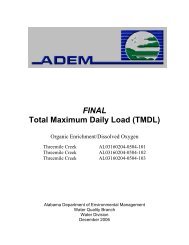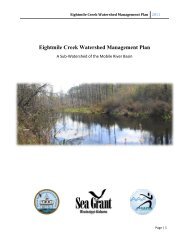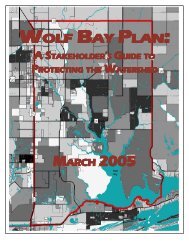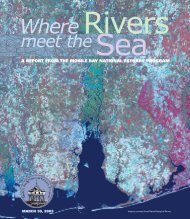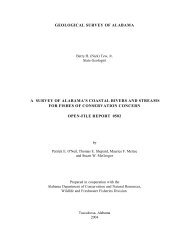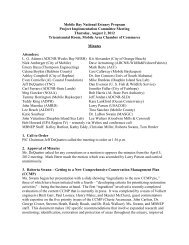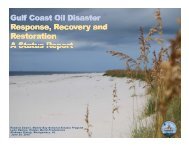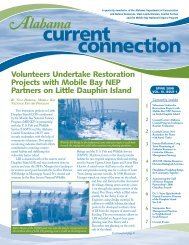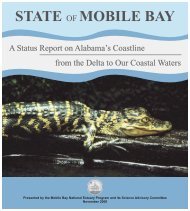Conserving Alabama's Coastal Habitats - Mobile Bay National ...
Conserving Alabama's Coastal Habitats - Mobile Bay National ...
Conserving Alabama's Coastal Habitats - Mobile Bay National ...
- No tags were found...
Create successful ePaper yourself
Turn your PDF publications into a flip-book with our unique Google optimized e-Paper software.
<strong>Mobile</strong> DeltaThe <strong>Mobile</strong>-Tensaw Delta conservation area, located in southwest Alabama, is part of the East Gulf <strong>Coastal</strong> Plainecoregion and empties into <strong>Mobile</strong> <strong>Bay</strong>. The Tensaw Delta is defined as the area from the Alabama River cutoffsouthward to the upper end of <strong>Mobile</strong> <strong>Bay</strong> at U.S. Highway 90 within the ten foot contour interval. The Deltais approximately 45 miles long, averages 8 miles wide, and contains 400 square miles of wetland and aquaticecosystems. It drains an area of about 44, 000 square miles including 64% of Alabama and small portions ofGeorgia and Mississippi. The Delta and the adjacent <strong>Mobile</strong> <strong>Bay</strong> estuary compose one of the largest wetlandecosystems in the United States.The Delta comprises an extensive wetland ecosystem dominated by deeply flooded swamp forests, seasonallyflooded bottomland hardwoods, freshwater marshes and various aquatic communities. It is characterized by alarge number of distributary rivers, streams, bayous and creeks which form a maze of waterways.Habitat Strengths/ImportanceAn area of 190,000 acres of the Delta was designated as a <strong>National</strong> Natural Landmark in 1974, and four siteswithin the Delta are also listed on the <strong>National</strong> Register of Historic Places. The <strong>Mobile</strong>-Tensaw River Delta hasrecently been identified by Natural Heritage Program as one of the top priority sites for protection within the EastGulf <strong>Coastal</strong> Plain (EGCP) Ecoregion. As such it is deemed to be of irreplaceable value in protecting the full rangeof biodiversity of the EGCP which stretches from eastern Louisiana across coastal Mississippi and Alabama tosouthwest Georgia and the Florida panhandle.According to the Forever Wild ranking system, the <strong>Mobile</strong>-Tensaw Delta has been identified as one of their toppriorities for protection. The ADCNR Game & Fish Division has also listed the <strong>Mobile</strong>-Tensaw Delta as one oftheir highest priorities for inclusion into the state Wildlife Management Area System. Furthermore, the <strong>Mobile</strong>-Tensaw Delta has been identified in a recent nationwide study to be one of the 15% of small watershed areas inthe U.S. recognized as being critical to conserve the nation’s at-risk fish and mussel species (Master et al, 1998).As such, the <strong>Mobile</strong>-Tensaw Delta is one of 327 watersheds (of the 2,100 in the U.S.) to be deemed as being ofirreplaceable value to conserving populations of all freshwater fish and mussel species at risk in the United States.The Bottomland hardwood forests within the Delta are wetland forests that are composed of a diverse assortmentof hydric hardwoods which occur on the rich alluvial soils of silt and clay deposited along several Panhandle riversincluding the Apalachicola, Choctawhatchee, and Escambia. These communities are characterized by an overstorythat includes water hickory, overcup oak, swamp chestnut oak, river birch, American sycamore, red maple, Floridaelm, bald cypress, blue beech, and swamp ash. (Source: http://myfwc.com/wildlifelegacy/pdf/Habitat Categories.pdf)The Tensaw Delta’s freshwater marshes are wetland communities dominated by a wide assortment of herbaceousplant species growing on sand, clay, marl, and organic soils in areas of variable water depths and inundationregimes. Generally, freshwater marshes occur in deeper, more strongly inundated situations and are characterizedby tall emergents and floating-leaved species. Freshwater marshes occur within flatwoods depressions, alongbroad, shallow lake and river shorelines, and scattered in open areas within hardwood and cypress swamps. Also,other portions of freshwater lakes, rivers, and canals that are dominated by floating-leaved plants such as lotus,spatterdock, duck weed, and water hyacinths are included in this category. Freshwater marshes are commonfeatures of many river deltas, such as the Escambia, Apalachicola and Choctawhatchee, where these rivers dischargeinto estuaries.34



